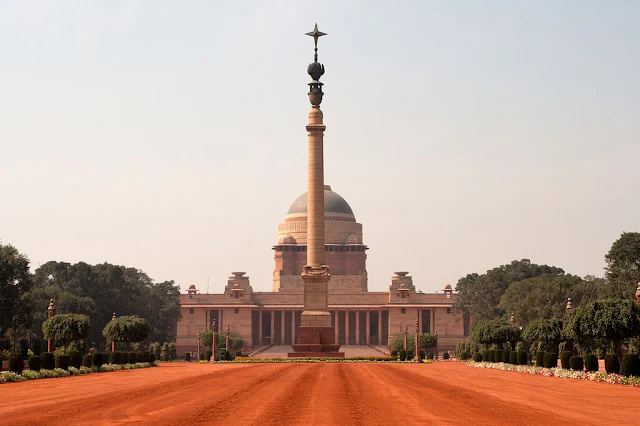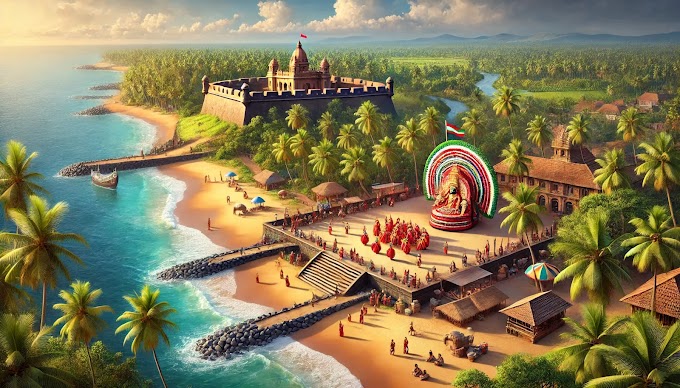 |
Image Source - Google | Image By Name: Christian Haugen from Trondheim, Norway |
Discover the Grandeur and History of Rashtrapati Bhavan – Timings, Entry Fees, and Best Time to Visit
Introduction: Rashtrapati Bhavan, the official residence of the President of India, is one of the largest and most magnificent palaces in the world. Located at the western end of Rajpath in New Delhi, it is not just a symbol of political power but also a stunning architectural marvel that showcases Indian and Western classical influences. Built during the British era, Rashtrapati Bhavan is a must-visit for anyone keen on exploring the rich history and beauty of India’s heritage.
History of Rashtrapati Bhavan:
The construction of Rashtrapati Bhavan commenced in 1911 after the Delhi Durbar, where it was announced that the capital of India would be shifted from Calcutta to Delhi. The building was completed in 1929, after nearly 18 years of work. It was originally built as the Viceroy’s House during British colonial rule, and designed by architect Edwin Lutyens, who played a key role in planning and constructing New Delhi. It was originally built as the Viceroy’s House intended to serve as the residence for the British Viceroy during their rule in India. After independence in 1947, it was converted into the official residence of the President of India. The palace was designed by British architect Edwin Lutyens in collaboration with Herbert Baker, and it is widely regarded as one of the most impressive government residences in the world.
Covering an area of 330 acres, the entire complex houses the main building with over 340 rooms, including the Durbar Hall, Ashoka Hall, Mughal Gardens, and various other sections. The grandeur of the structure is visible in its blend of Mughal and European architecture, reflecting India’s rich cultural diversity.
Architectural Significance:
The architectural brilliance of Rashtrapati Bhavan lies in its harmonious blend of Indian and Western styles. The massive dome, inspired by the Great Stupa of Sanchi, and the use of Mughal motifs such as Jali work (lattice designs) are notable features. The building is constructed with sandstone, marble, and red bricks, with intricate carvings that add to its elegance.
Mughal Gardens, located within the complex, is a stunning blend of Persian and Indian garden styles. Spanning over 13 acres, these gardens are open to the public during special times of the year, offering visitors a chance to witness their beauty when the flowers are in full bloom.
Must-See Attractions Inside Rashtrapati Bhavan:
- Durbar Hall: Known for its grandeur, Durbar Hall is where many significant national ceremonies, including the swearing-in of the President, are held.
- Ashoka Hall: This hall is adorned with beautiful paintings and intricate Persian art on the ceiling, adding to the opulence of the building.
- Mughal Gardens: One of the highlights of Rashtrapati Bhavan, the Mughal Gardens are known for their symmetrical layouts, fountains, and seasonal flowers.
- Presidential Museum Complex: Located within the premises, this museum houses significant artifacts and showcases the history of the Indian presidency.
Best Time to Visit Rashtrapati Bhavan:
The best time to visit Rashtrapati Bhavan is during the winter months, from November to February when the weather is pleasant and ideal for exploring the gardens and outdoor areas. The Mughal Gardens are usually open to the public during February and March, offering a breathtaking view of the blooming flowers.
Visiting Timings and Entry Fees:
- Timings: Rashtrapati Bhavan is open for visitors on Friday, Saturday, and Sunday from 9:00 AM to 4:00 PM. However, the Mughal Gardens have separate seasonal visiting hours, generally from February to March.
- Entry Fee: The entry fee is ₹50 per person. Children below the age of 8 are free. Online registration is mandatory for visiting.
How to Reach Rashtrapati Bhavan:
- Nearest Metro Station: Central Secretariat Metro Station on the Yellow and Violet Lines is the closest metro station to Rashtrapati Bhavan.
- By Road: The complex is well connected by road, and taxis, buses, and auto-rickshaws are easily available.
Nearby Attractions:
- India Gate: Located a short distance from Rashtrapati Bhavan, this war memorial is a must-visit for history enthusiasts.
- Rajpath: The ceremonial boulevard in New Delhi, which connects Rashtrapati Bhavan to India Gate.
- Gurudwara Bangla Sahib: A prominent Sikh temple known for its peaceful ambiance and stunning architecture.
Conclusion:
A visit to Rashtrapati Bhavan offers a unique glimpse into the grandeur and elegance of India’s political and historical legacy. From its sprawling gardens to its rich architectural details, every corner of the complex is a testament to India’s diverse heritage. Plan your visit to witness the splendor of this monumental site and explore one of the most significant symbols of Indian governance and culture.






